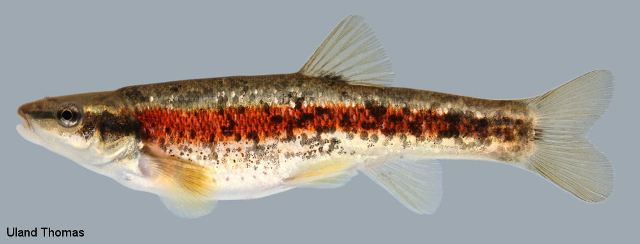Western Blacknose Dace
( Rhinichthys obtusus)

Members of genus Rhinichthys are sometimes called the "riffle daces" because they prefer clear waters with swift currents over a rocky substrate. Male western blacknose dace (left) can have a deep rusty red stripe along their side.
Description
Western blacknose dace have an olive to dark brown back, lighter sides, and a cream colored belly. They also have black blotches scattered across their back and sides. They have a dark mid-lateral stripe from the snout to the base of the tail. This stripe is black or brown in females (and young) and a rusty red in males. The snout is relatively long, and they have a slightly sub-terminal (ending below tip of snout) mouth. Like other species of dace they have very small scales which gives them the appearance of having none at all. They differ from the closely related longnose dace by having a shorter snout, larger eye, and a distinct mid-lateral stripe.
Habitat and Habits
The blacknose dace is found in small streams and brooks in Ohio having moderate or high gradients, clear waters, and clean substrates composed of sand, gravel, and cobble. These fish are typically found in fast water where there are overhanging roots or undercut banks. They can also be found in riffles hiding under large rocks or boulders. This species is more tolerant to increased water turbidities than other species of dace found in Ohio streams, but disappears if riffle substrates become too silted.
Reproduction and Care of the Young
Western Blacknose Dace spawn during spring and early summer in riffles over shallow gravel. Most spawn at two years and live for three or four years of age. Unlike other species of dace the two Ohio Rhinichthys species do not spawn in the nests of larger minnow species.